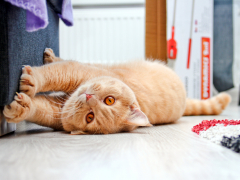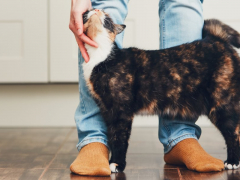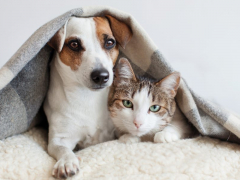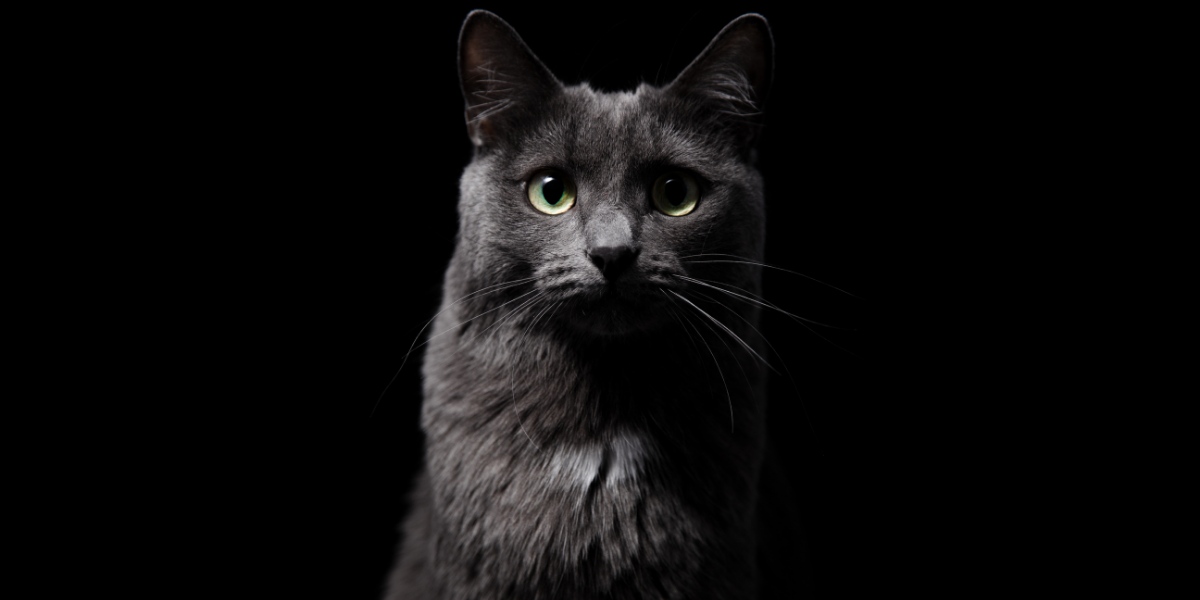
Your cat’s midnight zoomies and early morning escapades might disrupt your sleep, but have you ever wondered how your cat manages to get into so much trouble when all the lights are off? Some say that cats see in the dark.
This conjures images of either supernatural creatures or Navy Seals wearing night-vision goggles. Not surprisingly, neither of these comparisons adequately relate to your cat. In fact, it’s not completely true to say that cats see in the dark.
To truly appreciate your cat’s vision and how they navigate in low light conditions, you first have to understand the biological differences between feline and human vision. Here’s what you need to know.
How Can Cats See in the Dark
Both cats and humans have two types of photoreceptors in their retinas. These cells are called rods and cones. While cones mainly deal with allowing the eyes to detect and differentiate colors, rods are especially sensitive to light and are responsible for all vision in low-light conditions.
Without cones, a person (or cat) would not be able to see color during the day. And without rods, a person (or cat) would be night blind.
One of the main differences between feline and human retinas is the number of rods and cones. Cats have significantly fewer cones than humans, and they do not possess the specific photoreceptors that detect colors in the red-orange wavelengths. This is why cats are partially colorblind and don’t see colors the same way as humans.
How Well Can Cats See in the Dark
However, what cats lack in cones, they make up for in rods. Cats have somewhere between 6 and 8 times more rods than humans. All of those light-sensitive cells give them the ability to absorb more light and see in conditions that would have humans pulling out a flashlight.
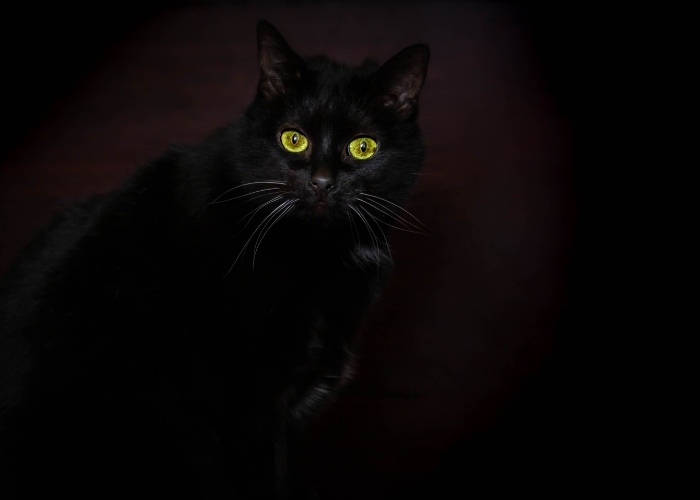
Many mammals have a tapetum lucidum, but humans aren’t on the list. We stumble along in the dark with our average number of cones and no reflective membrane.
Tapetum Lucidum in Cats
Along with extra rods, cats have another biological advantage when it comes to seeing in the dark. The tapetum lucidum is a thin, reflective layer of tissue located between the lens and retina. Its purpose is to reflect light back through the retina to increase the amount of usable light for the rods. It’s also responsible for the eerie eyeshine that makes feline eyes glow when light hits them in the dark. Other animals, including dogs, deer, horses, and cattle also have this anatomical advantage.
Many mammals have a tapetum lucidum, but humans aren’t on the list. We stumble along in the dark with our average number of cones and no reflective membrane.
*Don’t confuse the “red-eye” that can sometimes appear in photographs as the eyeshine caused by a tapetum lucidum. That demonic red glow is only the flash of the camera reflecting off the retina and illuminating the eye’s blood vessels.
The Shape of Their Eyes
A final feline advantage comes with the shape and function of different parts of the eye. Your cat’s eye has a proportionally large and curved cornea. This is the clear, outer layer of the eyeball. The extra size allows more light to enter the eye.
As you move further into the eye’s anatomy, the design of the circular pupil also affects a cat’s night vision. Cats have split pupils that are sensitive to light and capable of extreme dilation. This is why when you look at your cat while they’re sitting in the sun, their pupils are thin little slits. This protects their eyes from bright light. It also explains why cats don’t need to squint in bright conditions or wear sunglasses. When it’s nighttime, however, the pupils expand to let in more light. A cat’s pupil can expand to be 50% larger than a human’s.
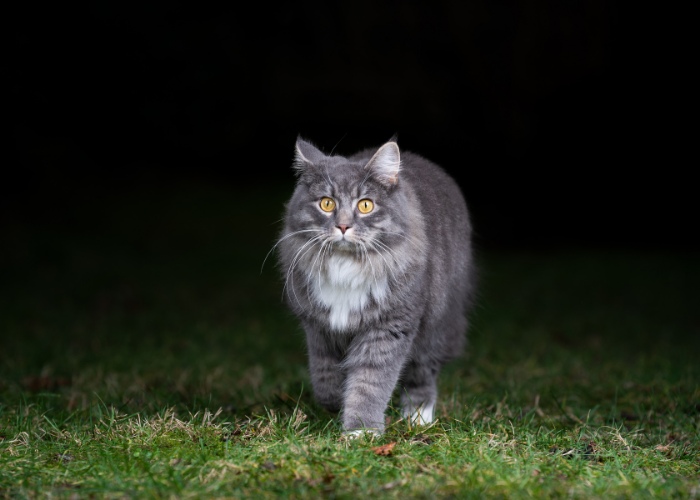
Cats can, however, see in conditions that we humans would consider to be “dark.”
Is Cat Night Vision Really That Good?
Now that you know a little more about the anatomy of the feline eye, you can note the difference between seeing in the dark and being able to see in low-light situations. No animal (that we’re aware of) can truly see in the dark. This would mean being able to see clearly when there is absolutely no light. As far as we know, this isn’t possible.
Cats can, however, see in conditions that we humans would consider to be “dark.” The rods in their retinas, the tapetum lucidum, their large corneas, and split pupils allow them to use a small amount of light with extreme efficiency. This is how cats can hunt prey and navigate by starlight alone. It’s also how your living room lion can knock everything off the counter using only the light from the digital clock on your oven.
As crepuscular creatures (meaning most active at dusk and dawn), cats use this visual superpower to guide their everyday lives, whether it’s daytime or the middle of the night.
Frequently Asked Questions
Can cats see better than dogs in the dark?
When it comes to seeing in the dark, cats rule. Cats have more rods than dogs, and this gives them the advantage once the sun goes down. It's predicted that cats can see four times better than dogs in low light condition.
Do cats know humans can't see in the dark?
There's no evidence to suggest that cats understand how other species, including humans, function differently. They likely recognize that humans are physically different, but recognizing less obvious characteristics, like how we stumble in the dark, is beyond their comprehension.
Can cats see color in the dark?
Cats have fewer cones than humans and completely lack the specific photoreceptors needed to detect colors in the red-orange wavelength. This leaves them partially colorblind, but they can see some colors. When navigating in dim conditions, cats can't see fine details or clear colors, but their vision is significantly better than that of a human.
How far can cats see in the dark?
While cats are better at seeing in low light, they aren't good at seeing far away objects. They are nearsighted, which means objects more than 20 feet away appear unfocused. This is true whether it's day or night.
-
https://www.rd.com/article/can-cats-see-in-the-dark/
-
https://www.nytimes.com/2014/06/03/science/how-cats-see-in-the-dark.html#:~:text=%E2%80%9CA%20cat's%20eye%20has%20a,visual%20advantages%20as%20well%2C%20Dr.
-
https://vcahospitals.com/know-your-pet/do-cats-see-color#:~:text=The%20ability%20to%20differentiate%20colors,red%2C%20blue%2C%20and%20green.
-
https://www.businessinsider.com/pictures-of-how-cats-see-the-world-2013-10
-
https://carnegiemnh.org/meowfest-why-do-cat-eyes-glow-in-the-dark/#:~:text=The%20tapetum%20lucidum%20reflects%20visible,out%20of%20the%20cat's%20eyes.



